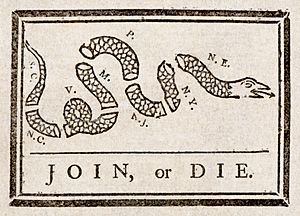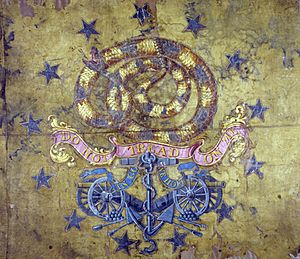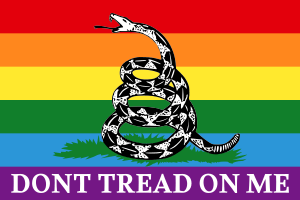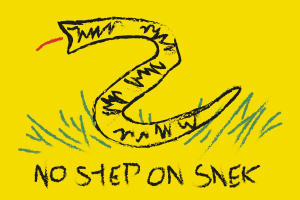Gadsden flag facts for kids
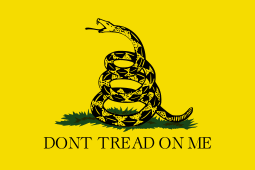 |
|
| Use | Banner |
|---|---|
| Proportion | Not specified |
| Adopted | 1775 |
| Design | A yellow banner charged with a yellow coiled timber rattlesnake facing toward the hoist sitting upon a patch of green grass, with thirteen rattles for the thirteen colonies, the words "DONT TREAD ON ME" positioned below the snake in black. |
| Designed by | Christopher Gadsden |
The Gadsden flag is a famous American flag from a long time ago. It has a bright yellow background with a timber rattlesnake coiled up, ready to strike. Below the snake, it says: "Dont tread on me" in big letters. Some newer flags might have an apostrophe in "Don't."
This flag is named after a person named Christopher Gadsden (1724–1805). He designed it in 1775 during the American Revolution. The flag was used by the Continental Marines, who were early American soldiers. It was a motto flag, like the Moultrie flag. The flag's design is a strong warning. It shows that people are watchful and ready to defend themselves if someone tries to control them. Because of this, the flag is linked to ideas of individualism and liberty. In the United States, it often stands for ideas like right-libertarianism, classical liberalism, and small government. It can also show distrust or challenge against authorities.
Contents
What the Gadsden Flag Looks Like and Means
Different Ways the Flag Appears
There are many different versions of the Gadsden flag. Sometimes the motto says "Don't tread on me" with an apostrophe. Other times, it's "Dont tread on me" without one. The letters used for the motto can also look different. The rattlesnake is usually shown resting on green grass. But some older flags from 1885 and 1917 don't have anything under the snake. The rattlesnake usually faces to the left. However, some flags show the snake facing to the right.
How the Rattlesnake Became an American Symbol
The timber rattlesnake lives in the area where the first Thirteen Colonies were. Like the bald eagle, this snake was special because it was only found in the Americas. This made it a good way to show that Americans were different from people in Europe.
The idea of using the rattlesnake as a symbol for the American colonies started with Benjamin Franklin. In 1751, he wrote about the rattlesnake in a funny article in his newspaper, the Pennsylvania Gazette. At that time, the British Parliament sent criminals to America. Franklin joked that Americans should send rattlesnakes back to Britain to thank them.
In 1754, during the French and Indian War, Franklin published a woodcut called Join, or Die. It showed a snake cut into eight pieces. Each piece stood for a different colony. New England was the head, and South Carolina was the tail. This was the first political cartoon ever printed in an American newspaper.
Later, in 1774, Paul Revere put Franklin's snake cartoon on the newspaper Massachusetts Spy. In this picture, the snake was fighting a British griffin.
In December 1775, Benjamin Franklin wrote an essay. He suggested that the rattlesnake was a good symbol for the American spirit. He said it showed being watchful, strong, independent, united, and free. He wrote that the snake has no eyelids, so it's always watching. It never attacks first, but once it starts, it never gives up. He also noted that the snake's rattles are separate but strongly connected, like the colonies.
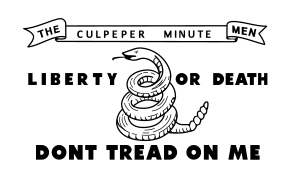
The rattlesnake symbol was officially used by the Continental Congress in 1778. They put it on the seal for the War Office. The seal had a rattlesnake holding a banner that said, "This we'll defend." This rattlesnake symbol has been used by the US Army for over 243 years.
Other American flags also use a rattlesnake. These include flags like The United Companies of the Train of Artillery of the Town of Providence and the First Navy Jack.
In recent times, the Gadsden Flag has been used by the Tea Party movement.
The Flag's History
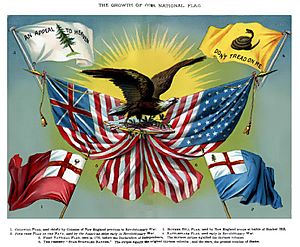
In the fall of 1775, the Continental Navy was created by General George Washington. The first ships were used to stop British ships carrying war supplies. This was important because the American army needed supplies during the American Revolutionary War. The Second Continental Congress also created five companies of Marines to go with the Navy.
Colonel Christopher Gadsden was from South Carolina. He was one of seven people who helped get the first naval mission ready. The first Marines joined in Philadelphia. They carried drums painted yellow with a coiled rattlesnake and the motto "Don't Tread on Me." This was the first time the Gadsden flag's symbols were mentioned.
Before the first mission left in December 1775, Commodore Esek Hopkins received a yellow rattlesnake flag from Gadsden. This flag was for Hopkins' main ship. Hopkins had led a group called The United Companies of the Train of Artillery of the Town of Providence, which had a similar flag. The flag was a warning to Great Britain. It told them not to take away the liberties of the American people. By late 1775, many Americans saw themselves as free individuals, not just subjects of the King. This belief helped the flag become popular.
Gadsden also gave a copy of this flag to the South Carolina Congress in Charleston, South Carolina. This was written down on February 9, 1776:
Col. Gadsden presented to the Congress an elegant standard, such as is to be used by the commander in chief of the American Navy; being a yellow field, with a lively representation of a rattlesnake in the middle in the attitude of going to strike and these words underneath, "Don't tread on me."
How the Gadsden Flag Is Used Today
The Gadsden flag is still flown a lot in Charleston, South Carolina. This is because Christopher Gadsden first showed the flag there. It was used often during the American Revolution in that city.
The Gadsden flag has become a popular design for special license plates in many states. As of 2022, states like Alabama, Arizona, Kansas, Maryland, Missouri, Montana, Oklahoma, South Carolina, Tennessee, Texas, and Virginia offer these plates.
A Symbol for Individual Rights
In the 1970s, the Gadsden flag started to be used by libertarians. They used it to represent individual rights and a government that doesn't have too much power. The flag's bright yellow color is also strongly connected to libertarian ideas.
Used to Show Disagreement with Authority
The Gadsden flag has also been used by groups who want to challenge the government or established systems. For example, it was seen during the January 6, 2021 storming of the United States Capitol.
Used by the Tea Party Movement
Starting in 2009, the Gadsden flag became a very common protest symbol for the American Tea Party movement. Members of Congress also showed the flag at Tea Party rallies. Because of this strong connection, the flag was sometimes seen as a political symbol, not just a historical or military one.
Legal Discussions About the Flag
In 2014, a US Postal Service employee complained about a coworker wearing a hat with a Gadsden Flag design at work. The postal service first dismissed the complaint. But the United States Equal Employment Opportunity Commission asked for a careful investigation. The EEOC made it clear that they did not say the Gadsden flag was a "racist symbol." They also did not say that wearing it was racial discrimination.
Used by Minority Self-Defense Groups
In the 1990s, a queer self-defense group called Street Patrol used a coiled snake as its logo. The snake was over a triangle and held a ribbon with "Don't Tread on Me." Some groups use a version of the flag with the snake and motto on a rainbow flag.
Funny Versions of the Flag
There are also funny versions of the Gadsden flag. One common design changes "Don't tread on me" to "No Step on Snek." Sometimes, it has a simple, funny drawing of a snake.
The Gadsden Flag in Movies and Music
In Film and Television
- In the TV show Jericho, the flag appears several times. In the last episode, the acting mayor takes down another flag and puts up a Gadsden Flag.
- In some episodes of Parks and Recreation, the character Ron Swanson has a Gadsden Flag in his office.
- It appears in The Office in the Michael Scott's Film Threat Level Midnight.
In Music
- The American heavy metal band Metallica has a song called "Don't Tread on Me." It's on their album released in 1991. The album cover shows a dark picture of a coiled rattlesnake, like the one on the Gadsden Flag.
Images for kids
-
Gadsden Flag flown during the January 6, 2021 storming of the U.S. Capitol.
-
The Gadsden flag next to the Confederate battle flag at a demonstration by far-right groups in Charlottesville.
See also
 In Spanish: Bandera de Gadsden para niños
In Spanish: Bandera de Gadsden para niños


